This article mainly introduces an in-depth understanding of Angular4 subscription (Subscribe) and cancellation, and introduces the use of subscription and cancellation in detail. It has certain reference value. Interested friends can refer to it. I hope it can help everyone.
Subscribe
Everyone who has written js knows that subscribe can be seen in many places and plays a very important role. Listening to the return of http requests, passing parameters between pages... Speaking of subscriptions, we can't help mentioning Observable, and talking about Observables, we can't help mentioning Subscribable... Wait, it's too far. Back to the topic, subscribe is a function under the Observable class. It can be seen from the Chinese name of Observable: "observable" that the role of Observable is similar to monitoring, but its monitoring is often across pages. For example:
// 父页面
export class SupComponent {
id: string;
// 父组件构造器
constructor(private router: Router) {
// 设置id
this.id = 'JvsBRBQHU2BthZQNYrBkVl0Z22zQQIkP';
}
// 进入详情页
detail(id: string) {
// 携带id跳转至详细页
this.router.navigate(['sub', id]);
}
}
// 子页面
export class SubComponent implements OnInit{
// 子组件构造器
constructor(private activated: ActivatedRoute) { }
// 子组件初始化钩子
ngOnInit(): void {
// 订阅活动路由
this.activated.params.subscribe(params => {
console.info(params['id']);
});
}
}The above describes a simple business code: click an element item in the list page, then jump to the detail page of the element, and get the id of the element in the detail page. At this time, we can see that subscribing to events comes in handy.
Unsubscribe(Unsubscribe)
At this time, I was thinking that in order to avoid memory overflow in JAVA, it is recommended that we close the stream for reading and writing files and make the object empty. Do I need to cancel my subscription? In the official documentation, we see a sentence:

That is to say, the component's hook will help us cancel the subscription and does not require us to cancel. Well, whatever you say is what it is. Today (of course today is when I am blogging), I encountered a simple requirement: the user clicks the 'Modify Information' button on the 'User Information' page to jump to the form page for modifying information. Of course, the initial information of the form is the one before the user changes the information. This is no problem. Then, in order to send as few useless requests as possible (users are allowed to submit without changing the data), I judged it in the DoCheck hook. If the data is different before and after, I made the button clickable. The code:
// 修改资料页面
export class ModifyUerInfo implements OnInit, DoCheck {
// 用户实体
user: User;
// 表单组
form: FormGroup;
// 声明订阅对象
subscript: Subscription;
// 修改资料页构造器
constructor(private builder: FormBuilder) {
// 实例化用户实体
this.user = new User();
// 实例化订阅对象
this.subscript = new Subscription();
}
// 修改资料页初始化钩子
ngOnInit(): void {
// 调用初始化表单函数
this.initForm();
}
// 修改资料检测变动钩子
ngDoCheck(): void {
this.subscript = this.form.valueChanges.subscribe(data => {
// 若表单无改动,data为null
if (data == null) {
// 这里要协同html进行不可点击操作,比较简单,就不贴代码了
return;
}
// 让提交按钮可以点击
console.info(data);
})
}
// 初始化表单方法
initForm() {
// 初始化表单
this.form = this.builder.group({
// 声明昵称填写项(假装这里有值)
nickname: [this.user.username, Validators.required],
// 声明年龄填写项(假装这里有值)
age: [this.user.age, Validators.required]
})
}
}Okay After saving the code, when I happily looked at the console results:

Each red line represents that I changed the form once. Please look at the picture to find the pattern~ Looking for your sister!
It can be found that when the form is changed n times, n+1 logs will be generated, and they will be n+1 changed form information. Although the official said that there is no need to cancel the subscription, if so many subscription objects are generated quickly on the mobile terminal, it is inevitable that there will be no problems. And as a programmer with ideals and pursuits, he cannot tolerate such imperfect situations. .
So in the callback function, I added:
// 取消订阅 this.subscript.unsubscribe();

At this time, restore the ideal state and call it a day!
To be honest, standardized code can not only improve the readability of the code, make the logic clearer, make the goddess admire you, and allow the boss to increase his salary... The most important thing is that it can prevent the program from causing errors. There are many avoidable mistakes that still need to be noted.
Related recommendations:
Detailed explanation of when to unsubscribe in Angular
node.js publish-subscribe mode Method
Detailed explanation of JavaScript publish-subscribe mode usage
The above is the detailed content of Detailed explanation of Subscription and cancellation in Angular4. For more information, please follow other related articles on the PHP Chinese website!
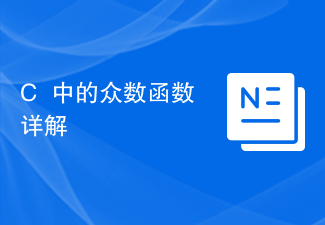 C++中的众数函数详解Nov 18, 2023 pm 03:08 PM
C++中的众数函数详解Nov 18, 2023 pm 03:08 PMC++中的众数函数详解在统计学中,众数指的是一组数据中出现次数最多的数值。在C++语言中,我们可以通过编写一个众数函数来找到任意一组数据中的众数。众数函数的实现可以采用多种不同的方法,下面将详细介绍其中两种常用的方法。第一种方法是使用哈希表来统计每个数字出现的次数。首先,我们需要定义一个哈希表,将每个数字作为键,出现次数作为值。然后,对于给定的数据集,我们遍
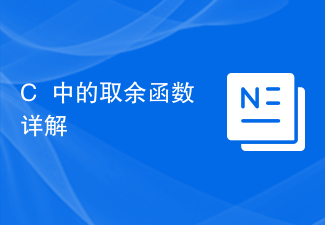 C++中的取余函数详解Nov 18, 2023 pm 02:41 PM
C++中的取余函数详解Nov 18, 2023 pm 02:41 PMC++中的取余函数详解在C++中,取余运算符(%)用于计算两个数相除的余数。它是一种二元运算符,其操作数可以是任何整数类型(包括char、short、int、long等),也可以是浮点数类型(如float、double)。取余运算符返回的结果与被除数的符号相同。例如,对于整数的取余运算,我们可以使用以下代码来实现:inta=10;intb=3;
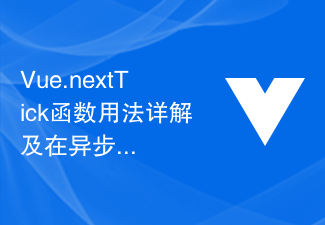 Vue.nextTick函数用法详解及在异步更新中的应用Jul 26, 2023 am 08:57 AM
Vue.nextTick函数用法详解及在异步更新中的应用Jul 26, 2023 am 08:57 AMVue.nextTick函数用法详解及在异步更新中的应用在Vue开发中,经常会遇到需要进行异步更新数据的情况,比如在修改DOM后需要立即更新数据或者在数据更新后需要立即进行相关操作。而Vue提供的.nextTick函数就是为了解决这类问题而出现的。本文就会详细介绍Vue.nextTick函数的用法,并结合代码示例来说明它在异步更新中的应用。一、Vue.nex
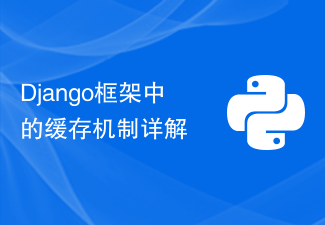 Django框架中的缓存机制详解Jun 18, 2023 pm 01:14 PM
Django框架中的缓存机制详解Jun 18, 2023 pm 01:14 PM在Web应用程序中,缓存通常是用来优化性能的重要手段。Django作为一款著名的Web框架,自然也提供了完善的缓存机制来帮助开发者进一步提高应用程序的性能。本文将对Django框架中的缓存机制进行详解,包括缓存的使用场景、建议的缓存策略、缓存的实现方式和使用方法等方面。希望对Django开发者或对缓存机制感兴趣的读者有所帮助。一、缓存的使用场景缓存的使用场景
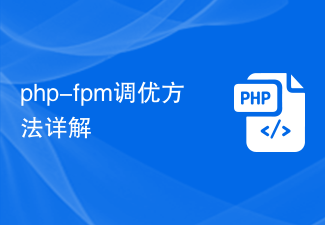 php-fpm调优方法详解Jul 08, 2023 pm 04:31 PM
php-fpm调优方法详解Jul 08, 2023 pm 04:31 PMPHP-FPM是一种常用的PHP进程管理器,用于提供更好的PHP性能和稳定性。然而,在高负载环境下,PHP-FPM的默认配置可能无法满足需求,因此我们需要对其进行调优。本文将详细介绍PHP-FPM的调优方法,并给出一些代码示例。一、增加进程数默认情况下,PHP-FPM只启动少量的进程来处理请求。在高负载环境下,我们可以通过增加进程数来提高PHP-FPM的并发
 PHP function_exists()函数用法详解Jun 27, 2023 am 10:32 AM
PHP function_exists()函数用法详解Jun 27, 2023 am 10:32 AM在PHP开发中,有时我们需要判断某个函数是否可用,这时我们便可以使用function_exists()函数。本文将详细介绍function_exists()函数的用法。一、什么是function_exists()函数?function_exists()函数是PHP自带的一个内置函数,用于判断某个函数是否被定义。该函数返回一个布尔值,如果函数存在返回True,
 Gin框架的模板渲染功能详解Jun 22, 2023 pm 10:37 PM
Gin框架的模板渲染功能详解Jun 22, 2023 pm 10:37 PMGin框架是目前非常流行的Go语言Web框架之一。作为一个轻量级的框架,Gin提供了丰富的功能和灵活的架构,使得它在Web开发领域中备受欢迎。其中一个特别重要的功能是模板渲染。在本文中,我们将介绍Gin框架的模板渲染功能,并深入了解它的实现原理。一、Gin框架的模板渲染功能Gin框架使用了多种模板渲染引擎来构建Web应用程序。目前,它支持以下几种模板引擎:
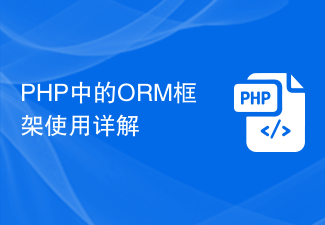 PHP中的ORM框架使用详解Jun 23, 2023 am 11:22 AM
PHP中的ORM框架使用详解Jun 23, 2023 am 11:22 AMORM(Object-RelationalMapping)框架是一种用于将面向对象编程语言中的对象模型与关系型数据库之间映射的技术。它使开发人员能够使用面向对象的方式操作数据库,而不需要直接操作SQL语言。在PHP开发领域中,ORM框架也得到了广泛的应用。本文将详细介绍PHP中的ORM框架使用方法。一、ORM框架的优点使用ORM框架有以下优点:1.提高开发


Hot AI Tools

Undresser.AI Undress
AI-powered app for creating realistic nude photos

AI Clothes Remover
Online AI tool for removing clothes from photos.

Undress AI Tool
Undress images for free

Clothoff.io
AI clothes remover

AI Hentai Generator
Generate AI Hentai for free.

Hot Article

Hot Tools

Dreamweaver CS6
Visual web development tools

WebStorm Mac version
Useful JavaScript development tools

Zend Studio 13.0.1
Powerful PHP integrated development environment

SAP NetWeaver Server Adapter for Eclipse
Integrate Eclipse with SAP NetWeaver application server.

Safe Exam Browser
Safe Exam Browser is a secure browser environment for taking online exams securely. This software turns any computer into a secure workstation. It controls access to any utility and prevents students from using unauthorized resources.





